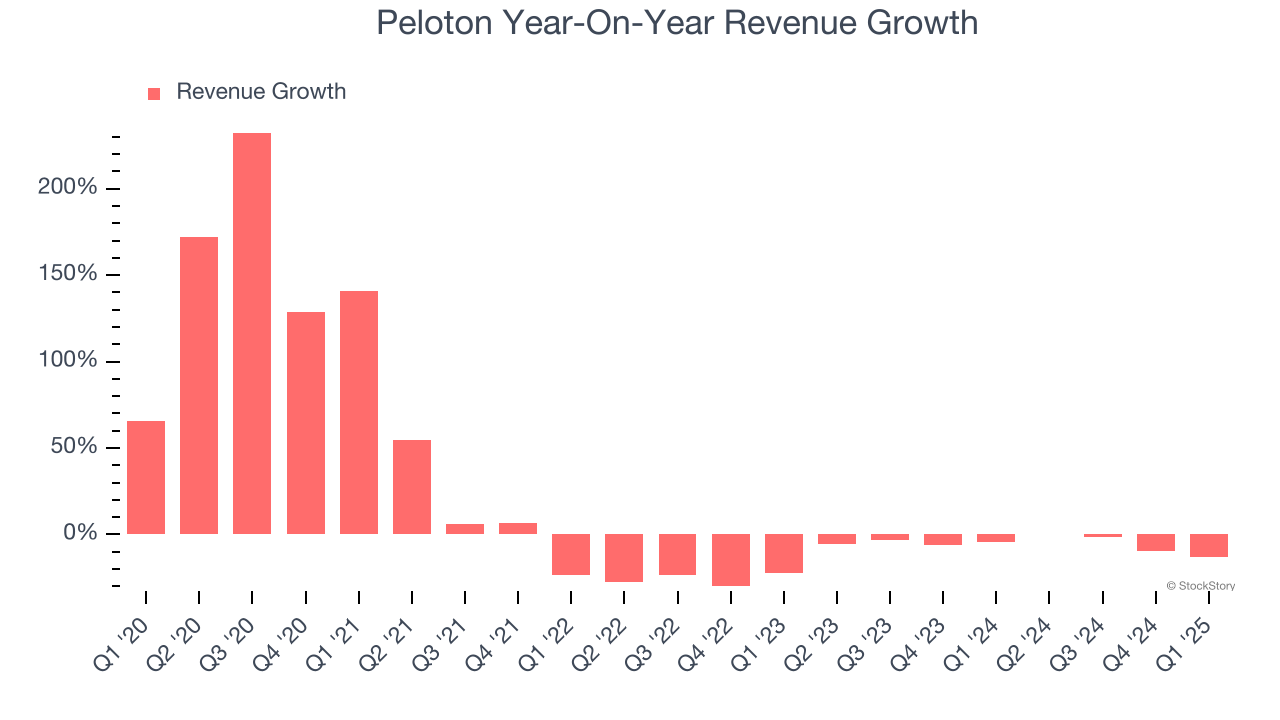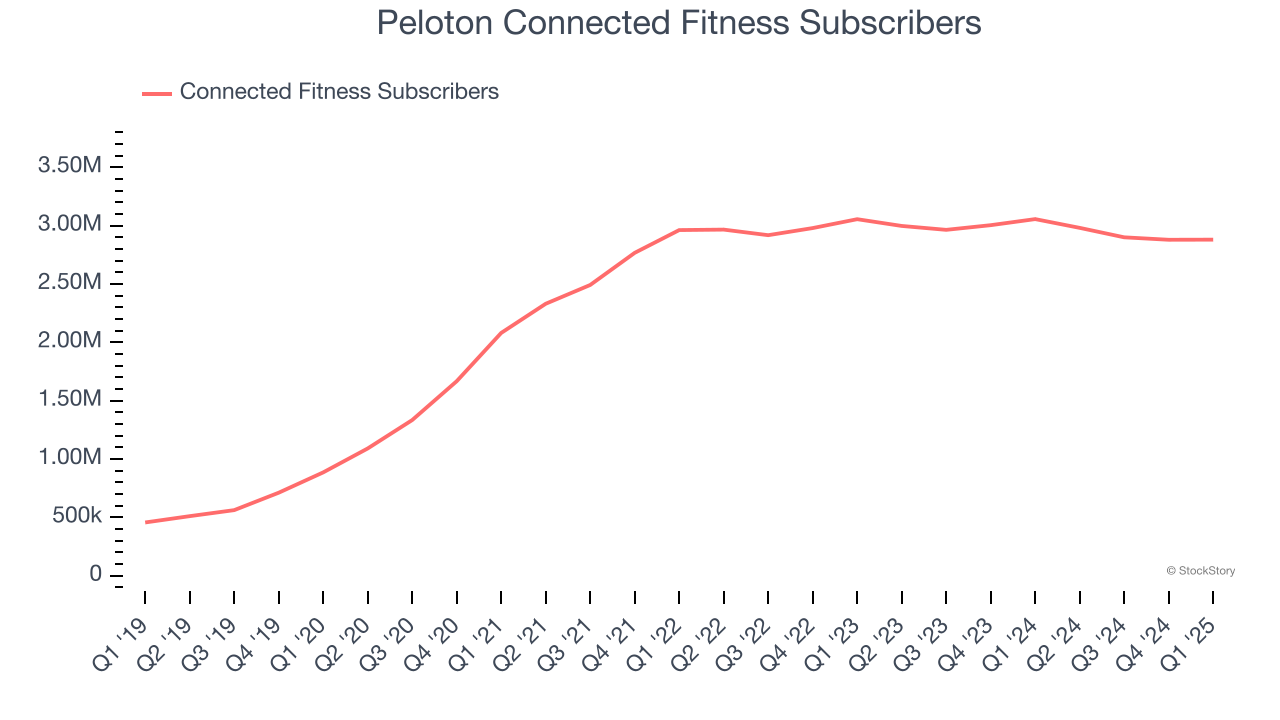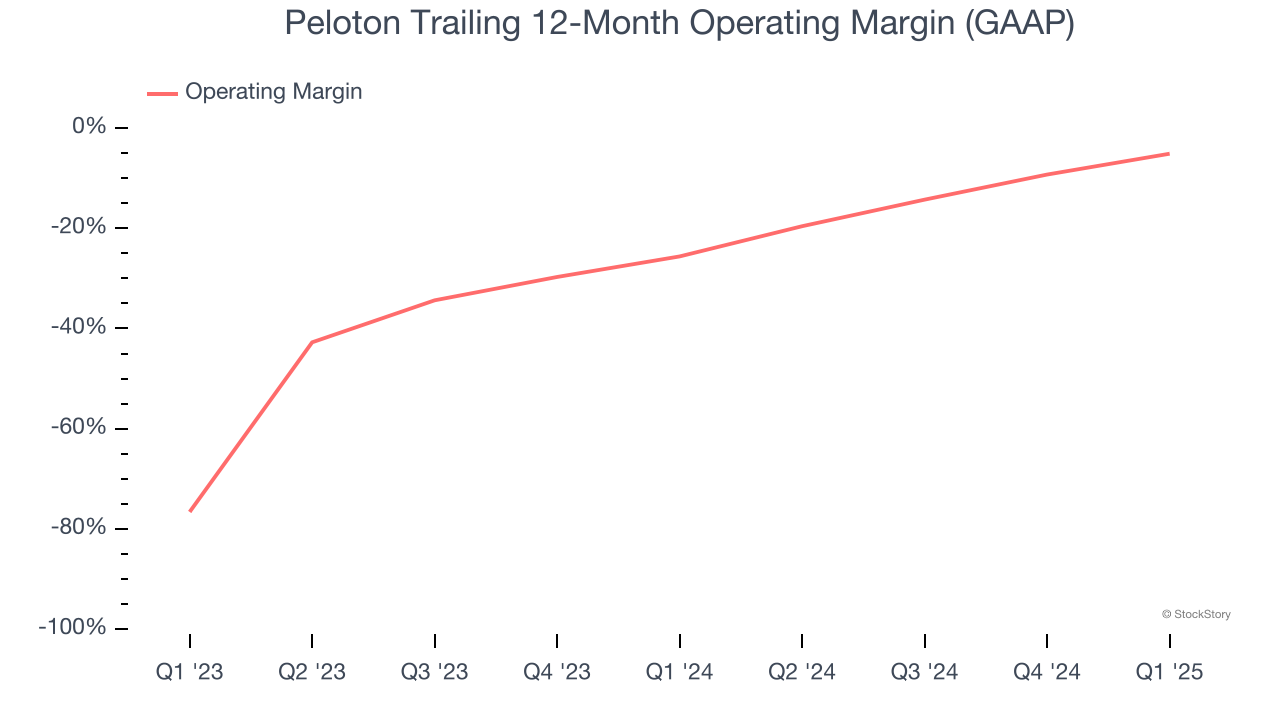
Exercise equipment company Peloton (NASDAQ: PTON) met Wall Street’s revenue expectations in Q1 CY2025, but sales fell by 13.1% year on year to $624 million. The company’s outlook for the full year was close to analysts’ estimates with revenue guided to $2.46 billion at the midpoint. Its GAAP loss of $0.12 per share was 97.4% below analysts’ consensus estimates.
Is now the time to buy Peloton? Find out by accessing our full research report, it’s free.
Peloton (PTON) Q1 CY2025 Highlights:
- Revenue: $624 million vs analyst estimates of $621.5 million (13.1% year-on-year decline, in line)
- EPS (GAAP): -$0.12 vs analyst expectations of -$0.06 (97.4% miss)
- Adjusted EBITDA: $89.4 million vs analyst estimates of $80.37 million (14.3% margin, 11.2% beat)
- The company slightly lifted its revenue guidance for the full year to $2.46 billion at the midpoint from $2.46 billion
- EBITDA guidance for the full year is $340 million at the midpoint, below analyst estimates of $345 million
- Operating Margin: -5.2%, up from -20.4% in the same quarter last year
- Free Cash Flow Margin: 15.2%, up from 1.2% in the same quarter last year
- Connected Fitness Subscribers: 2.88 million, down 176,000 year on year
- Market Capitalization: $2.72 billion
Company Overview
Started as a Kickstarter campaign, Peloton (NASDAQ: PTON) is a fitness technology company known for its at-home exercise equipment and interactive online workout classes.
Sales Growth
A company’s long-term sales performance can indicate its overall quality. Any business can have short-term success, but a top-tier one grows for years. Over the last five years, Peloton grew its sales at a 11.9% annual rate. Although this growth is acceptable on an absolute basis, it fell short of our standards for the consumer discretionary sector, which enjoys a number of secular tailwinds.

We at StockStory place the most emphasis on long-term growth, but within consumer discretionary, a stretched historical view may miss a company riding a successful new product or trend. Peloton’s performance shows it grew in the past but relinquished its gains over the last two years, as its revenue fell by 5.6% annually. 
We can dig further into the company’s revenue dynamics by analyzing its number of connected fitness subscribers, which reached 2.88 million in the latest quarter. Over the last two years, Peloton’s connected fitness subscribers averaged 1.1% year-on-year declines. Because this number is higher than its revenue growth during the same period, we can see the company’s monetization has fallen. 
This quarter, Peloton reported a rather uninspiring 13.1% year-on-year revenue decline to $624 million of revenue, in line with Wall Street’s estimates.
Looking ahead, sell-side analysts expect revenue to decline by 4.2% over the next 12 months, similar to its two-year rate. While this projection is better than its two-year trend, it's tough to feel optimistic about a company facing demand difficulties.
Software is eating the world and there is virtually no industry left that has been untouched by it. That drives increasing demand for tools helping software developers do their jobs, whether it be monitoring critical cloud infrastructure, integrating audio and video functionality, or ensuring smooth content streaming. Click here to access a free report on our 3 favorite stocks to play this generational megatrend.
Operating Margin
Operating margin is a key measure of profitability. Think of it as net income - the bottom line - excluding the impact of taxes and interest on debt, which are less connected to business fundamentals.
Peloton’s operating margin has been trending up over the last 12 months, but it still averaged negative 15.7% over the last two years. This is due to its large expense base and inefficient cost structure.

In Q1, Peloton generated a negative 5.2% operating margin. The company's consistent lack of profits raise a flag.
Earnings Per Share
We track the long-term change in earnings per share (EPS) for the same reason as long-term revenue growth. Compared to revenue, however, EPS highlights whether a company’s growth is profitable.
Although Peloton’s full-year earnings are still negative, it reduced its losses and improved its EPS by 34.8% annually over the last five years. The next few quarters will be critical for assessing its long-term profitability.

In Q1, Peloton reported EPS at negative $0.12, up from negative $0.45 in the same quarter last year. Despite growing year on year, this print missed analysts’ estimates. Over the next 12 months, Wall Street is optimistic. Analysts forecast Peloton’s full-year EPS of negative $0.44 will reach break even.
Key Takeaways from Peloton’s Q1 Results
It was encouraging to see Peloton beat analysts’ EBITDA expectations this quarter. On the other hand, revenue was just in line and its full-year EBITDA guidance fell slightly short of Wall Street’s estimates. Overall, this was a softer quarter, and the market needs more convincing performance from this turnaround. The stock traded down 8.2% to $6.41 immediately following the results.
The latest quarter from Peloton’s wasn’t that good. One earnings report doesn’t define a company’s quality, though, so let’s explore whether the stock is a buy at the current price. What happened in the latest quarter matters, but not as much as longer-term business quality and valuation, when deciding whether to invest in this stock. We cover that in our actionable full research report which you can read here, it’s free.





